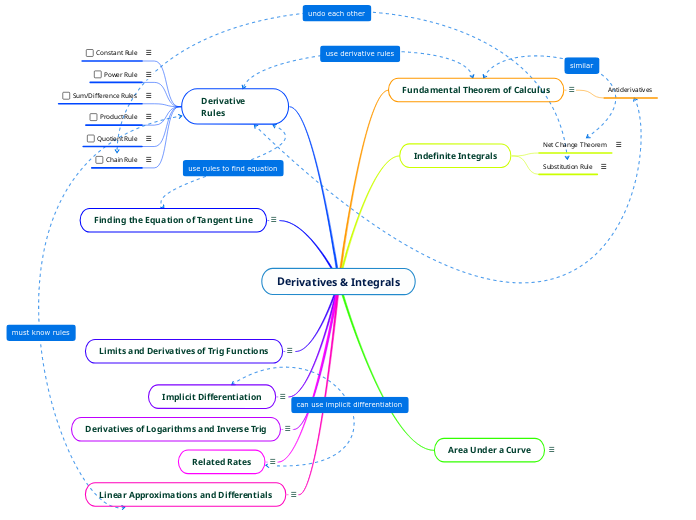作者:Colin Williams 3 年以前
367
Derivatives & Integrals

作者:Colin Williams 3 年以前
367

更多类似内容
The Linear Approximation to f at a is the linear function:
Related rates are referring to the numbers or measurements that are being compared by way of a ratio. We are concerned with a special ratio in which the two terms that are being compared are in two different units of measure.
For example, is referring to the change in area with respect to the change in radius. How fast is the area changing when the radius changes?
When doing related rate problems it will be helpful to know some general math equations such as the equation for the area of circle, volume of a cube, and the equation for the area of a triangle, etc.
Natural Log:
Ex.
Inverse Trig Functions:
Remembering you trig identities such as SOHCAHTOA and the Pythagorean Identities will help you manipulate equations when you need to find the derivative.
if (sin should be raised to -1) then
Derivative of Logs
Implicit Equations are equations that are not written in terms of only one variable.
The notation means you take the derivative of y with respect to x.
derivative of sin(x) is equal to the limit of sin(x+h) minus sin(x) all over h as h goes to zero.
It is helpful to know your trig identities when taking the derivative of trig functions that way you can better manipulate the equation.
To find the equation of a tangent line to a given function at a given point we use . In order to use this form we need to find the output or the y value of the original function at the given point and the derivative of the given function and plug the given x value in. Then take these values and plug into the given form and simplify.
Function within a function
The derivative of the inside times the derivative of the outside.
Ex.
we set "u" equal to sin x and f(u) equal to u raised to the 4th power, then find the derivative of both and multiple together substituting sin x into the derivative of f(u).
The derivative of the top times the bottom minus the derivative of the bottom times the top all over the bottom squared.
The derivative of the first times the second plus the derivative of the second times the first.
should be nx to the power of n-1.
Ex.
The derivative on a constant is just zero.
Ex.
There are 3 different ways to choose the values for x1,x2,x3 etc.
The change in x is equal to
If is a differentiable function whose range is an interval I and f is continuous on I, then the integral of is equal to the integral of
Ex.
Find the integral of
First set and
Then say and get dx alone
Next step would be to go back to the original integral and
substitute u for and for the 4x at the front
and the 4x in the denominator will cancel leaving you with
the integral of which will be then
we will substitute our 'u' which was for the 'u' which
will give us
Link:
Substitution Rule and Chain Rule undo each other.
The integral of the rate of change is the net change.
The integral of from a to b is equal to
The area function with constant endpoint 'a' is
equals the integral of from a to x. where you take the given 'x' and make that the endpoint, where x is greater than or equal to a. This gives us the net area of the region bounded by the graph of f and the t-axis on the interval [a,x]
is equal to the integral of from a to x. and
The integral of from a to b is equal to
where F is any antiderivative of f, a function in which
Link:
Knowing your derivative rules will make understanding this much easier since integrals and derivatives are inverses of one another. You will also use the derivative rules to find the net area function.